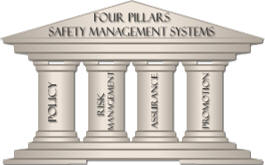|
|
|||||||||
|
|
|
| SMS Introduction |
|
|
|
|
|
|
|
|
|
|
|
|
|
|
| SMS Solutions |
|
|
|
|
|
|
|
|
|
|
|
|
| Order Now |
|
|

|
(Last Revision: Nov. 16, 2010) Risks It took just over a century of flight for the arrival to the industry of a comprehensive, systematic, formal approach to safety. The nuclear power industry, space, pharmaceuticals, chemicals; they have all embraced SMS for years due to the obvious inherent risks involved in their operations that are transmitted to their customers and/or surrounding environment. Rarely mentioned in aviation advertising are the inherent risks of flight that cry for mitigation but they are there for you and me to worry about every time we board an aircraft. Long overdue, we finally have a risk-based business decision process that takes management bias out of the equation.
Whats It All About? ICAO (International Civil Aviation Organization) through its member states has adopted Annex 6 which requires each member state to require the implementation of SMS by its aviation service providers. Very simply, this means States shall establish a safety program, in order to achieve an acceptable level of safety in the operation of aircraft. States shall require as part of their safety program, that an operator implements a safety management system acceptable to the State of the Operator that, as a minimum:
A A safety management system shall clearly define lines of safety accountability throughout the operators organization, including a direct accountability for safety on the part of senior management.
You Can Run but You Cant Hide strong For the first time in aviation history aviation managerial accountability has arrived. With an adequate SMS (Safety Management System) fully implemented into an aviation service providers organization as soon to be mandated by the FAA (Federal Aviation Administration), safety issues will no longer languish for action due to cost issues or managerial bias. From any source, when a safety issue arises and enters the SMS, formal processes take over to manage that issue from recording it, to risk assessment, to mitigation of risk to an acceptable level, through follow up ensuring that mitigation strategies continue to work. No longer will operations with unacceptable risk be conducted. No longer will known high-risk hazards be allowed to exist for very long. And that is the crux of the matter for management accountability. Someones name will be associated with the acceptance of any risk level that has been formally assigned to any known hazard. And, for that reason alone, as if there werent many good ones, managers must be careful that the tools they use do the right job in a timely manner with the hazards that are now tied to them. Managers must think twice about the quality of their organizations talents in SRM (Safety Risk Management), one of the four pillars of SMS.
SMSMS in a Nutshell Dr. Don Arendt, SMS program manager for the FAA has a simple SMS definition. "It is not a safety program, it is about decision making and posits safety as part of the decision-making management process just like any other part of running a business," the FAA man said. "It has a set of practices - a policy - that gives it a structure. It is nothing more than looking at your operation and your environment and finding out what hazards are there and deciding what you are going to do about them. The other side of it we call safety assurance, and we take steps to gain confidence that our processes are working using evaluating tools like auditing. I investigate where I've made shortfalls and have a management-review process to make sure the controls are working."
FOUR PILLARS OF SAFETY MANAGEMENT SYSTEMS:
NTSB Board Member Robert Sumwalt succinctly puts SMS in a nutshell with this description of the components of SMS. He believes "you can make these things as complex as you want to" but all SMSs are composed of four components.
The FAA's Arendt believes that the SMS concept is "overrated in terms of complexity." It can be either a complicated process or simple and straightforward, he said, "and the latter is what we are trying to make it. Document your process accurately, but don't over-document it. It is all about decision making. Collect the information you need to make good decisions and use it. Have repeatable processes." These goals are not simple to accomplish for established companies with long-held management concepts and biases. This is a relatively new way of doing business, of conducting management of a business and the climate in which it flourishes is open, honest and transparent with risk-based decision-making. To borrow a concept from Southwest Airlines; in a climate where all employees feel empowered to do the right thing, safety can flourish.
CHARCHARACTERISTICS OF A SYSTEMS APPROACH TO SAFETY MANAGEMENT:
Advice for Safety Managers Keep SMS implementation as simple as you can, cover the basics before you embark on ambitious goals. Crawl before you walk; walk before you run and get a good head start before you takeoff for the clouds. Start simple and small with manageable implementation phases one at a time, at your own pace, within your budget, with the people you have. Make your tools work for you; not the other way around. Take it one step at a time and youll get there. The concept of the Internal Evaluation Program is based on the premise of verifying compliance with safety regulations in accordance with FAA HBAT 99-19 and Advisory Circular 120-59.
For more information on how your company can quickly gain these advantages, please email one of our Senior Consultants to find out more
|

